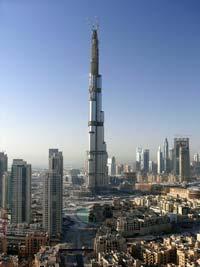World’s biggest tower the last mega-project for Dubai

The Dubai debt crisis is causing ripples of concern amongst the Gulf state’s 200,000 Filipino workers as word is spreading about how serious the financial crisis is in the city-state.
Many are now learning of the extent of the crisis and there is a growing expectation they will be heading home or to another destination for work.
On Nov. 25, Dubai World and its main property subsidiary Nakheel asked for a six-month standstill on 59 billion dollars in debts, which caused wide-spread panic and worries in the financial sector across the world.
In response, the United Arab Emirates (UAE)’s central bank on Sunday established an emergency facility to aid bank liquidity, but development of the crisis was being closely watched as fears of another wave of financial crisis accumulated.
Dubai is one of the seven emirates that make up the UAE and boasted mushrooming skyscrapers and fast growing financial muscles in recent years.
Meanwhile in the Philippines, a top Philippine labour official said Manila stands ready to help if job loss spreads to the Filipino community.
Labor Secretary Marianito Roque told a press briefing that the government is prepared to implement a “remedial action” once it receives reports of contract termination among Filipino workers in Dubai.
“My expectation is that it would not reduce our numbers in deployment or employment rate and it will not have a serious effect on our remittances,” Roque said.
The Philippine economy heavily depends on remittance sent home by around 11 million overseas workers. The remittance accounts for an estimated US$16 billion each year, or around 10 percent of the country’s gross domestic product (GDP).
Money sent home by overseas Filipinos is critical to sustaining household consumption in the country.
“The fear of losing jobs in Dubai or abroad can have greater devastating consequences in the family members at home,” said a professor at the Center For Pastoral Family Mysteries of Jesuit Ateneo de Manila University.
For this reason, the Filipino “government should try to create more job opportunities at home” so that “Filipinos would not look for jobs abroad.”
About 2,000 Filipinos leave the country every day because of high levels of unemployment at home.
Meanwhile Labour Secretary Roque said that in case Filipino workers are hit by the Dubai crisis, the government’s “plan of action” is to find new employment opportunities for them in the other six emirates in the United Arab Emirates that are not as badly hit as Dubai, and also in other Gulf countries.
Before last year’s credit crunch, Dubai and the rest of the United Arab Emirates were estimated at the end of 2007 to have a population of 6.4 million people – of whom 5.5 million were foreigners.
More than three million were registered with the ministry of labour as workers, when Dubai was still racing to build enormous shopping centres and business districts.
But now the picture is very different. Even before state-owned Dubai World said last week that it wants to halt payments on its huge debts for at least six months, property prices were down by half and office rents by as much as two-thirds.
People from Asia, who form the majority of the construction workforce, may find their livelihoods at stake following the mothballing of hundreds of new building projects worth tens of billions of dollars.
Of the estimated 350,000 to 500,000 Filipinos now living and working in the UAE, about 250,000 are based in Dubai. Many of these workers first arrived as “tourists”, adding to their vulnerability to deportation with the mounting downturn. Migrante, a non-government organization, reports that overseas foreign worker salary payments in the UAE now face delays.
Some foreign workers have agreed to take pay cuts rather than be sent back to the Philippines.
Burj Dubai Facts
The Burj Dubai rises up 2,684 feet (818 meters), well above the runner-up skyscraper, Taipei 101 in Taiwan, at 1,671 feet (508 meters). It has even pushed past other giant structures taller than Taipei 101 such as the CN Tower in Toronto and the KVLY-TV mast in North Dakota.
Designed by the Chicago-based architectural firm Skidmore, Owings & Merrill, The Burj is billed to have the world’s fastest elevator at up to 40 mph and can be seen as far as 57 miles away. It takes three months just to clean all the windows.
Yet the world most massive tower is opening at a time when Dubai is reeling in debt and the economy is tanking.
It’s not the first time a skyscraper has gone up as the economy swooned.
New York’s 102-story Empire State Building was designed as the world’s tallest building just before the 1929 stock market crash and opened in 1931 as the Great Depression was taking hold.
In 1999, the Petronas Towers in Kuala Lumpur, Malaysia, officially opened to claim the world-tallest crown — two years after the financial meltdown of the once-soaring Southeast Asian economies.






